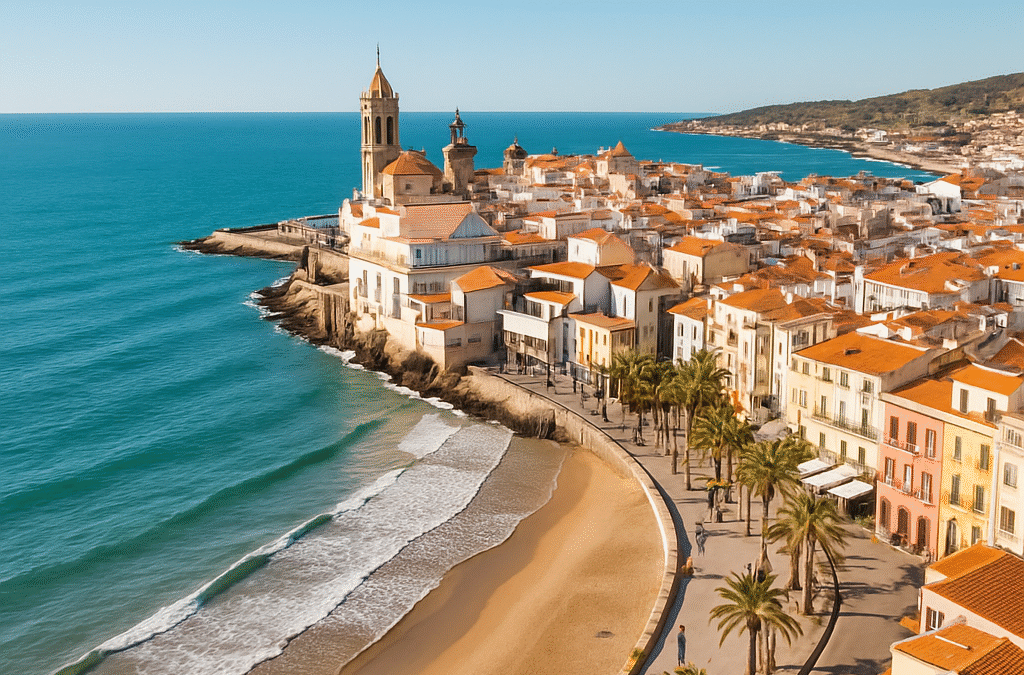While much of Europe chills in winter, you don’t have to surrender to grey skies. Europe has pockets of mild, sunny weather in winter — perfect for topping up Vitamin D, exploring with fewer crowds, and tasting seasonal local life without deep freeze. Below are seven of the best European picks for Australian travellers looking for a sunny winter European escape.
1. Canary Islands, Spain (Tenerife, Gran Canaria, Lanzarote, Fuerteventura)
Why go: These islands off the northwest African coast remain among Europe’s warmest winter escapes. Daytime temperatures often hover between 18 °C and 22 °C.
Top attractions:
- Teide National Park (Tenerife) for volcanic landscapes
- Roque Nublo hike (Gran Canaria)
- Timanfaya National Park in Lanzarote
- Sand dunes in Corralejo (Fuerteventura)
Local food to try:
- Papas arrugadas (wrinkled potatoes) with mojo rojo or mojo verde sauces
- Gofio (toasted cereal flour)
- Fresh seafood — grilled fish and viejas (parrotfish)
- Rancho Canario, a local meat and vegetable stew
2. Madeira, Portugal
Why go: Madeira offers mild winter sun, with averages around 16–20 °C, lush landscapes, and fewer rain days than mainland Portugal.
Top attractions:
- Levada walks (irrigation channels turned hiking paths)
- Botanical gardens in Funchal
- Monte Palace Tropical Garden
- Cable car rides and cliffside views
Local food to try:
- Espetada (beef kebabs with garlic and laurel)
- Scabbardfish with banana
- Bolo do Caco (Madeiran flatbread with garlic butter)
- Madeira wine, of course
3. Algarve, Portugal
Why go: The Algarve is a reliable winter choice. Coastal towns see daytime temperatures around 16 to 20 °C, with plenty of sunshine.
Top attractions:
- Coastal walks like the Seven Hanging Valleys Trail
- Benagil Cave boat trips
- Historic towns such as Lagos, Tavira, Silves
- Dolphin watching cruises
Local food to try:
- Arroz de lingueirão (rice with razor clams)
- Grilled sardines, cataplana (seafood stew)
- Dom Rodrigos sweets
- Algarve pork sausages, chouriço, morcela
4. Malta (Valletta & Islands)
Why go: Valletta was once named Europe’s sunniest capital. Winter temperatures range from 13 to 17 °C.
Top attractions:
- St. John’s Co-Cathedral
- Grand Harbour ferry and harbour views
- The Three Cities (Vittoriosa, Senglea, Cospicua)
- Megalithic temples like Ħaġar Qim and Mnajdra
Local food to try:
- Pastizzi (savoury pastry with ricotta or pea)
- Fenek (rabbit stew)
- Lampuki pie (seasonal fish pie)
- Maltese ftira and local olives
5. Seville / Andalusia, Spain
Why go: Seville can enjoy sunny winter days of 16–20 °C, making it ideal for exploring in comfort.
Top attractions:
- Royal Alcázar of Seville and gardens
- Seville Cathedral and La Giralda
- Plaza de España and Maria Luisa Park
- Flamenco tablaos and local barrios
Local food to try:
- Tapas — jamón ibérico, gambas al ajillo, patatas bravas
- Espinacas con garbanzos (spinach and chickpeas)
- Salmorejo (cold tomato soup)
- Churros con chocolate
6. Almería, Spain
Why go: Almería is one of Europe’s sunniest cities. In winter, daytime highs reach about 17–18 °C; it has never recorded anything below 0 °C historically.
Top attractions:
- Alcazaba of Almería (a Moorish fortress)
- Cable car to Cerro San Cristóbal
- Cabo de Gata Natural Park
- Beaches like Playa de los Genoveses
Local food to try:
- Gazpacho orajano
- Fresh seafood (prawns, dorada)
- Tapas almerienses — local cold dishes
- Caldero (rice and fish stew from the east coast)
7. Crete, Greece
Why go: Crete’s southern location gives milder winters. While nights can cool, days often reach 13–18 °C.
Top attractions:
- Palaces of Knossos and Minoan ruins
- Beaches like Elafonissi and Balos (milder for walking)
- Samaria Gorge (lower sections)
- Venetian harbour in Chania and old towns
Local food to try:
- Dakos (Cretan barley rusk with tomato, cheese, oil)
- Kserotigana, loukoumades (sweets)
- Fresh olive oil, wild greens (‘horta’)
- Gamopilafo (wedding rice dish)
- Local Cretan cheeses and raki
Tips for Aussie Travellers
- Best months: December through February — afternoons are comfortable, evenings chillier.
- What to pack: Layered clothes, a light wind jacket, sunglasses, comfortable walking shoes, sunscreen.
- Transport: Consider renting a car for islands or rural areas (Madeira, Algarve, Crete). Public transport works well in Seville and Malta.
- Crowds & costs: These destinations are quieter and cheaper in winter than summer.
- Festive touches: Many places still host Christmas markets, lights, and local events even in mild climates.
- Stay connected: You’ll want to get a Europe prepaid SIM so you can stay connected everywhere you go.

